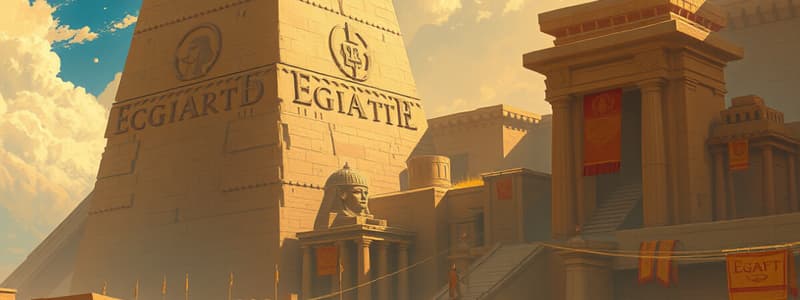Podcast
Questions and Answers
Egypt is located in southeastern Africa and the Middle East.
Egypt is located in southeastern Africa and the Middle East.
False (B)
The Great Pyramid of Giza was built during the New Kingdom period.
The Great Pyramid of Giza was built during the New Kingdom period.
False (B)
The Nile River is a key geographical feature of Egypt.
The Nile River is a key geographical feature of Egypt.
True (A)
Egypt's economy is predominantly based on industry and manufacturing.
Egypt's economy is predominantly based on industry and manufacturing.
Pharaohs in ancient Egypt were considered divine and held absolute power.
Pharaohs in ancient Egypt were considered divine and held absolute power.
The official language of Egypt is English.
The official language of Egypt is English.
The ancient writing system used in Egypt was called Coptic.
The ancient writing system used in Egypt was called Coptic.
Tourism is an important sector of Egypt's diverse economy.
Tourism is an important sector of Egypt's diverse economy.
Osiris and Ra were among the prominent deities in ancient Egypt's polytheistic religion.
Osiris and Ra were among the prominent deities in ancient Egypt's polytheistic religion.
Flashcards are hidden until you start studying
Study Notes
Geography
- Located in northeastern Africa and the Middle East.
- Bordered by the Mediterranean Sea to the north, Sudan to the south, and the Red Sea to the east.
- Key geographical features include the Nile River, the Sahara Desert, and the Sinai Peninsula.
History
- Ancient civilization known for its monumental architecture, including pyramids and temples.
- Key periods include:
- Pre-dynastic (c. 6000–3150 BCE): Development of agriculture and early settlements.
- Old Kingdom (c. 2686–2181 BCE): Era of pyramid construction, including the Great Pyramid of Giza.
- Middle Kingdom (c. 2055–1650 BCE): Period of stability and cultural flourishing.
- New Kingdom (c. 1550–1070 BCE): Egypt's imperial phase, featuring pharaohs like Ramses II and Tutankhamun.
Culture
- Religion: Polytheistic, with gods like Osiris, Isis, Horus, and Ra.
- Writing System: Hieroglyphics, used for religious texts and monumental inscriptions.
- Art and Architecture: Highly symbolic; characterized by statues, wall paintings, and massive stone structures.
Government
- Ruled by pharaohs who were considered divine and had absolute power.
- Government structure included a bureaucracy of officials, priests, and military leaders.
Economy
- Based on agriculture, primarily along the Nile River.
- Major crops: wheat, barley, and flax.
- Trade with neighboring regions for goods like gold, papyrus, and linen.
Modern Egypt
- Capital: Cairo, a major cultural and political center.
- Population: Over 100 million, predominantly Arab.
- Government: Republic with a president and a multi-party system.
- Economy: Diverse; important sectors include tourism, agriculture, and oil.
Language
- Official language: Arabic.
- Ancient language: Egyptian, which evolved through hieroglyphs to Coptic.
Key Issues
- Political instability and social unrest since the Arab Spring in 2011.
- Economic challenges, including high unemployment and inflation.
- Environmental issues, particularly water scarcity and pollution.
Tourism
- Major attractions: Pyramids of Giza, Luxor's temples, the Valley of the Kings, and the Nile cruise.
- Tourism is a vital part of the economy, contributing significantly to national income.
Geography
- Positioned at the junction of northeastern Africa and the Middle East.
- Bordered by the Mediterranean Sea (north), Sudan (south), and the Red Sea (east).
- Essential geographical features include the Nile River, the Sahara Desert, and the Sinai Peninsula.
History
- Home to one of the world's earliest civilizations, renowned for its monumental constructions such as pyramids and temples.
- Key historical periods:
- Pre-dynastic (c. 6000–3150 BCE): Farm development and establishment of early communities.
- Old Kingdom (c. 2686–2181 BCE): Noteworthy for the construction of iconic pyramids, especially the Great Pyramid of Giza.
- Middle Kingdom (c. 2055–1650 BCE): Characterized by a period of relative stability and advancements in culture.
- New Kingdom (c. 1550–1070 BCE): Time of imperial power, marked by prominent pharaohs like Ramses II and Tutankhamun.
Culture
- Religion was polytheistic, featuring deities such as Osiris, Isis, Horus, and Ra.
- Hieroglyphics served as the writing system for religious documents and monumental records.
- Artistic expressions were symbolically rich, with notable emphasis on statues, wall paintings, and grand stone designs.
Government
- Governed by pharaohs regarded as divine figures with total authority.
- Administered through a structured bureaucracy comprising officials, priests, and military commanders.
Economy
- Primarily agrarian, focused along the Nile River where fertile lands supported crop cultivation.
- Major agricultural products included wheat, barley, and flax.
- Engaged in trade with neighboring regions for commodities such as gold, papyrus, and linen.
Modern Egypt
- Capital city, Cairo, is a significant cultural and political hub.
- Population exceeds 100 million, primarily consisting of Arabs.
- Operates as a republic led by a president within a multi-party framework.
- Economic landscape is diverse, key sectors are tourism, agriculture, and oil production.
Language
- Arabic is the official language.
- The ancient Egyptian language evolved from hieroglyphs into Coptic.
Key Issues
- Experiencing ongoing political instability and social unrest, particularly since the Arab Spring of 2011.
- Facing economic difficulties, highlighted by high unemployment rates and inflation.
- Environmental concerns include water scarcity and rising pollution levels.
Tourism
- Major attractions encompass the Pyramids of Giza, Luxor's ancient temples, the Valley of the Kings, and scenic Nile cruises.
- Tourism plays a crucial role in the economy, significantly boosting national income.
Studying That Suits You
Use AI to generate personalized quizzes and flashcards to suit your learning preferences.




